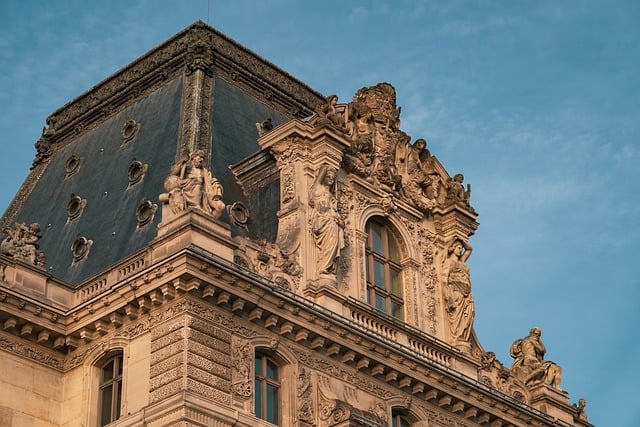In contemporary home architecture, modern roof aesthetics have evolved from a defect to a celebrated feature through asymmetrical designs. By incorporating varied rooflines, angles, and heights, architects create dynamic structures that challenge traditional symmetry, exude energy, and enhance visual appeal. This approach offers functional benefits like improved natural lighting and air circulation while pushing design boundaries and fostering individuality in modern homes, as seen in global case studies like Kengo Kuma Architecture's Japanese residence and MVRDV's Amsterdam complex.
Crafting bold, asymmetrical designs for contemporary homes is a daring yet rewarding endeavor. In this article, we explore the concept of modern roof aesthetics as a key element in defining and enhancing the unique character of residential spaces. From unlocking asymmetry’s potential to integrating functionality with form, we delve into innovative ideas that challenge conventional design norms. Discover captivating case studies showcasing how homes embrace asymmetric beauty, transforming ordinary spaces into extraordinary havens.
Unlocking Asymmetry: A Modern Approach to Home Design
Asymmetry, once considered a design flaw, has evolved into a powerful tool in contemporary home architecture. Unlocking the potential of asymmetrical layouts allows designers to create unique and striking modern roof aesthetics that captivate the eye. This approach challenges traditional symmetry, embracing a more dynamic and unconventional aesthetic. By playing with contrasting elements, such as varying rooflines, angles, and heights, architects can craft homes that feel alive and energetic.
The modern world demands design innovation, and asymmetrical design satisfies this need by offering a fresh perspective. It allows for dramatic first impressions and creates interior spaces that are both intriguing and functional. This style encourages creativity in every aspect of the home, from exterior cladding to window placements, ensuring the structure stands out as a testament to its era.
The Role of Roof Aesthetics in Contemporary Architecture
In contemporary architecture, the roof often moves beyond its traditional structural role and becomes a key design element. Modern roof aesthetics play a pivotal part in defining the overall look and feel of a home, contributing to its bold and asymmetrical appeal. The line between roof and skyline blurs, with designs that embrace unconventional shapes and angles, challenging the conventional rectangular profiles. This shift allows architects and designers to create dynamic facades and unique exterior spaces, transforming rooftops into works of art.
The integration of modern roof aesthetics requires a thoughtful approach, considering factors such as climate, orientation, and surrounding context. From bold overhangs that cast dramatic shadows to pitched roofs with unconventional pitches, these design choices can enhance natural lighting, improve energy efficiency, and create striking visual impacts. By embracing the potential of the roof as an expressive canvas, contemporary homes push boundaries, offering a fresh perspective on residential design.
Bold Ideas for Asymmetrical Rooflines
Modern homes often embrace a bold and unique approach to architecture, and one striking element that can truly capture attention is an asymmetrical roofline. This design choice adds a dynamic twist to contemporary aesthetics, moving away from traditional symmetry. By playing with varying slopes, angles, and heights, architects create visual interest and a sense of movement in the overall structure.
Asymmetrical roofs can range from subtle variations to dramatic shifts, offering a canvas for creative expression. For instance, a low-sloped gable paired with a steep, angled dormer creates a striking contrast, while a curved roofline breaking away from straight lines provides an organic touch. These modern roof aesthetics not only enhance the visual appeal but also offer functional benefits, such as improved drainage and natural light infiltration.
Integrating Functionality and Form: Creating Dynamic Spaces
In crafting bold asymmetrical designs for contemporary homes, the seamless integration of functionality and form is key to creating dynamic spaces that truly stand out. Asymmetry itself can be a powerful tool in modern roof aesthetics, breaking away from traditional symmetry and introducing a sense of movement and uniqueness. By thoughtfully arranging elements like varying roof lines, jutting angles, and unexpected curves, designers can craft homes that are both visually stunning and highly functional.
These dynamic spaces not only offer distinctive exteriors but also translate into interior layouts that maximize natural light, air circulation, and flexible living areas. Asymmetrical design elements can create intriguing visual paths, encouraging occupants to explore and interact with the space in novel ways. In essence, integrating functionality and form through bold asymmetry results in homes that are not just beautiful but also deeply satisfying to live in, embodying the spirit of contemporary design.
Case Studies: Homes that Embrace Asymmetric Beauty
In the realm of contemporary home design, embracing asymmetry can be a game-changer, creating a unique and captivating visual narrative. Case studies from around the globe showcase homes that beautifully embrace this aesthetic, challenging traditional symmetry. For instance, a residence in Japan designed by Kengo Kuma Architecture incorporates sweeping, organic shapes into its modern roof aesthetics, seamlessly blending with the surrounding natural landscape. The asymmetrical layout not only offers a striking view but also provides practical advantages, allowing for better natural light penetration and ventilation.
Another standout example is a residential complex in Amsterdam, where architects from MVRDV crafted a series of interconnected volumes that defy conventional geometry. The project, known for its vibrant and bustling atmosphere, features irregular facades and unconventional rooflines, adding a dynamic touch to the urban landscape. These bold designs not only cater to modern lifestyle needs but also serve as a testament to the beauty of breaking away from conventional design norms, fostering a sense of uniqueness and individuality in contemporary homes.
In conclusion, crafting bold asymmetrical designs for contemporary homes involves a harmonious blend of modern roof aesthetics and innovative architectural principles. By unlocking the potential of asymmetry, designers can create dynamic spaces that not only captivate the eye but also serve functional purposes. The case studies presented highlight successful implementations of these concepts, demonstrating how modern roof aesthetics can revolutionize home design while embracing unique beauty. Incorporating bold ideas for asymmetrical rooflines allows builders to navigate complex landscapes and create homes that stand out as testaments to contemporary style.
